Download a PDF of this report.
Summary
This report, which examines Fiscal Year 2022 enrollment in the United States Department of Agriculture’s (USDA) Environmental Quality Incentives Program (EQIP), is a follow-up to IATP’s Payments for Pollution report. Among other findings, this report again finds that industrial practices, or practices that are often structural rather than plant or natural systems-based, receive an outsize share of EQIP funding. Two of the top 10 EQIP practices by total dollar amount spent are practices we identified as industrial, providing little to no conservation benefits, in our previous report: waste facility cover and waste storage facility. Together, these two practices, which prop up harmful, polluting concentrated animal feeding operations (CAFOs), were awarded over $100 million of taxpayer dollars in 2022 under the guise of conservation. These two practices also appear on the top 10 list of most expensive practices on a per-contract basis. From this dishonorable top 10 list, at least eight could be considered industrial, with practices targeted toward large-scale, animal or commodity crop operations. The most expensive EQIP grant an individual farm can receive is for the construction of a methane digester, which is over $280,000 on average. We discuss the harms of these digesters further in the paper.
We contrast these expensive, industrial practices with some of the more popular, low cost, true conservation practices offered through EQIP. By steering away from six-figure industrial practices and toward lower cost practices that help farmers adapt to a changing climate and conserve soil and water, EQIP can serve more farmers and bring more conservation benefits. This is especially important in a time when USDA turned away roughly three in four farmers who applied for EQIP in 2022.
This paper also examines the state of water and agriculture in the U.S. as it relates to EQIP. Irrigation-related practices remained some of the more popular and costly uses of EQIP dollars in 2022. As climate change intensifies, droughts lengthen and aquifers deplete, there will likely be more demand for irrigation infrastructure. We discuss the need for better water use regulation across the country to lessen the strain on EQIP. Improvements in soil health, more thoughtful crop rotations and learning from traditional ecological knowledge can also go a long way in conserving the U.S.’ water resources.
EQIP is a program that is funded through the once-every-five-years Farm Bill. As the 2018 Farm Bill is set to expire on September 30, 2023, we believe this report is timely. As Congress debates and begins to write the 2023 Farm Bill, we hope this report can be a good resource in understanding how EQIP dollars are spent, and how the program can be retooled to build resilience for farms and farmers nationwide.
Introduction
We release this report in the wake of yet another report by the Intergovernmental Panel on Climate Change (IPCC) on the nature of the climate crisis. The IPCC report concludes that we are much closer to a warmer world than previously thought, leading to a different reality for billions of people across the globe.1 Effects once expected to occur decades in the future are happening now, leading to a new urgency for climate action by governments.
While Farm Bill conservation cost-share programs may not seem important when considering the global scale of climate change, they can help to reduce emissions and help farms become more climate resilient. Many farming practices supported by the Environmental Quality Incentives Program (EQIP) can build rich and healthy soils in a variety of climates, soils which are better able to withstand weather extremes such as floods and droughts.2 EQIP can also help farmers diversify their operations by removing some of the financial burden from conserving a farm’s soil and water.
To support climate resilience for the most farmers possible, EQIP should focus on practices that are both resilient and cost-effective. As IATP found in its 2022 Payments for Pollution report, a sizable chunk of EQIP dollars in the Midwest are spent on expensive practices that are not resilient and may in fact make the climate crisis worse. These practices include waste storage facilities and waste facility covers, practices intended to prevent seepage of liquid animal manure from CAFOs into local water supplies. These EQIP payments, which are essential nodes of many CAFO’s business plans, are among the most expensive practices and serve only a small number of farmers. CAFOs — specifically their large manure lagoons — are also a huge source of methane, a potent greenhouse gas, as well as ammonia, hydrogen sulfide and particulate matter,3 all of which pose risks to human health. Many rural communities stand in strong opposition to the pollution generated by CAFOs, and as others have written, CAFOs are also harmful from an animal welfare perspective.4
This report builds on Payments for Pollution in two important ways. First, it provides Fiscal Year 2022 data on practice usage and money spent. Second, this report takes a deep dive into EQIP practices nationwide, examining practices that may be common outside of the Midwest.
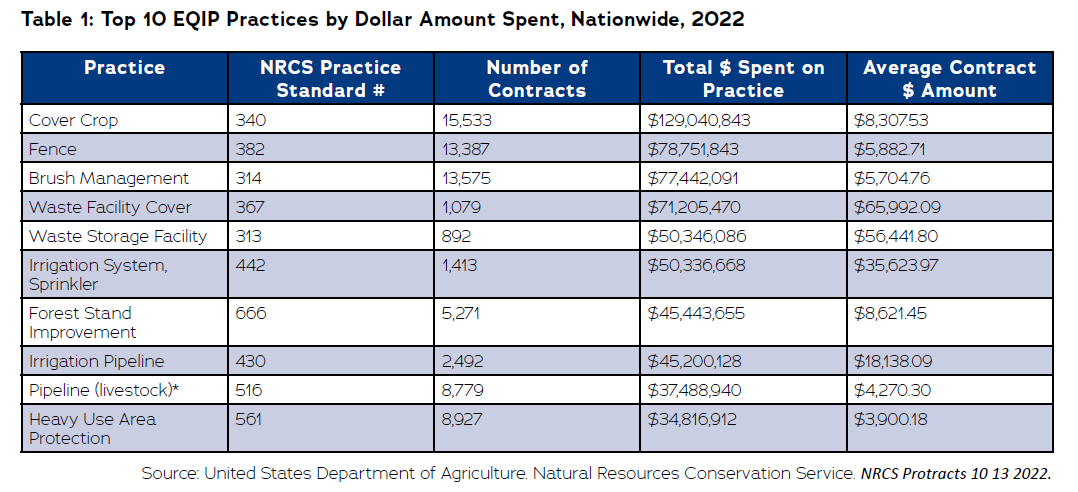
The above table displays the top 10 EQIP practices by dollar amount spent in 2022. Two of these practices, waste facility cover and waste storage facility, were included in our list of industrial practices in Payments for Pollution. Both are largely used by CAFOs to store liquid animal waste, a potent source of methane and risk for water supplies. These two practices are more expensive on a per-contract basis than others on the list, as they require large amounts of concrete and liner to prevent liquid waste from leaking into surrounding waterways and groundwater. Despite these protective measures, animal waste often escapes and contaminates local water. In North Carolina, where many hog CAFOs lie within 100 miles of the Atlantic Ocean, several hurricanes have struck and caused lagoons to overflow, including Hurricane Florence in 2018, Hurricane Matthew in 2016 and Hurricane Floyd in 1999.6
How does EQIP work?
Over 160 different practices are eligible for EQIP funding. Farmers who wish to implement EQIP conservation practices on their land work with local Natural Resources Conservation Service (NRCS) staff to determine which practice or practices make the most sense. Different regions of the country pose different resource concerns, such as water quality and wildlife habitat. Proposals for EQIP practices that address regional resource concerns are often ranked higher than those that do not. The regional resource concerns are determined by NRCS in consultation with county and state technical advisory committees (STACs), open to farmers, landowners, conservationists and members of the general public.
In most cases, a farmer will receive technical guidance on how to install an EQIP practice, pay for it, install it and then receive reimbursement from NRCS. Low-income farmers, farmers of color, veteran farmers, and new and beginning farmers can be eligible for advance payments so the up-front cost burden is lower.
We have provided the practice standard number used by the NRCS. A full and up-to-date list of practice standards and eligibility is available on the NRCS website.7

Anaerobic digesters: Costly and counterproductive
The single costliest practice eligible for EQIP payments is the anaerobic digester. In 2022, EQIP awarded $1,983,965 to just seven anaerobic digesters, all of which are in California. That comes out to an average of $283,424 per contract. Just one digester contract would be the equivalent of 4% of New Jersey’s entire EQIP allocation in 2022 or around 6.6% of Massachusetts’ allocation. The money spent on these seven digesters could instead have helped 238 farmers plant cover crops.
Expensive anaerobic digesters are most often installed at CAFOs to capture methane gas from manure lagoons. Once captured, methane gas is often channeled into natural gas pipelines. Digesters are key nodes in a growing movement to use biogas derived from animal manure for energy, sometimes under the guise of “green” or “renewable” energy. If the market for biogas continues to grow, with the help of state and federal subsidies, it will create further incentives to expand CAFOs to produce more manure. Livestock have the potential to be valued less for meat, dairy and wool and more for the waste they produce.
IATP has written about how biogas, and digesters in particular, is a false climate solution that further props up a polluting system of animal production, in which rural communities pay the price. Biogas diverts precious resources away from true solutions that reduce emissions and make the agricultural system more climate resilient.9 EQIP is not the only source of taxpayer dollars that can be used for methane digesters. The Rural Energy for America Program (REAP) run by USDA also provides public funding for biogas infrastructure, as do some state-level programs.10 With limited time to meet climate target dates set by the U.S. and global community, we cannot afford costly distractions such as biogas when other proven solutions exist and broader systems reforms are needed.
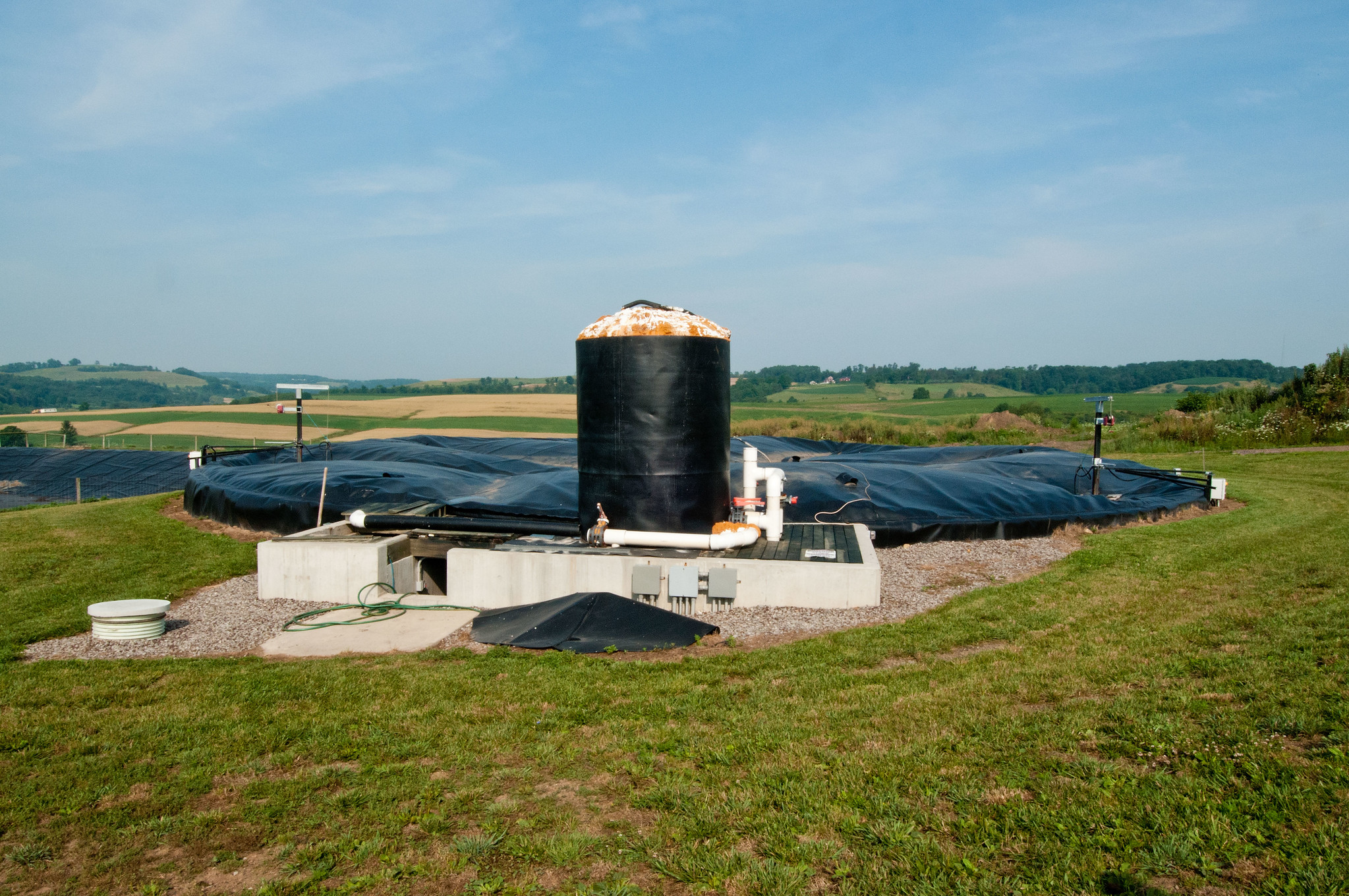
EQIP Improvement Act
When EQIP was first created in the 1996 Farm Bill, CAFOs were not eligible for funding through the program. The EQIP Improvement Act, a bill introduced in March 2023 by Senators Cory Booker (D-NJ) and Mike Lee (R-UT), would reform the way EQIP practices are prioritized, bringing the program more in line with its original intent of conservation while deprioritizing expensive practices that don’t have much environmental benefit. Sens. Booker and Lee have identified 25 practices currently eligible for EQIP funding that would have a lower federal cost-share. Under this bill, most EQIP practices would be eligible for 75% federal cost-share, whereas the practices in Table 3 would only be eligible for 40%. Additionally, all EQIP contract holders would only be eligible for less than $125,000 in payments over four years. The average contracts for the practices targeted under the EQIP Improvement Act are well below the payment limits, indicating that only the largest contracts and largest farms would be affected.
Many of the practices that IATP identified as industrial in Payments for Pollution are reflected in the list below. These practices are italicized. As we highlighted in the 2022 report, our list of 10 practices was not exhaustive, but rather examples of the cost, scale and effects of EQIP payments for practices that are not effective at conserving the environment and may in fact make the climate and conservation crises worse.
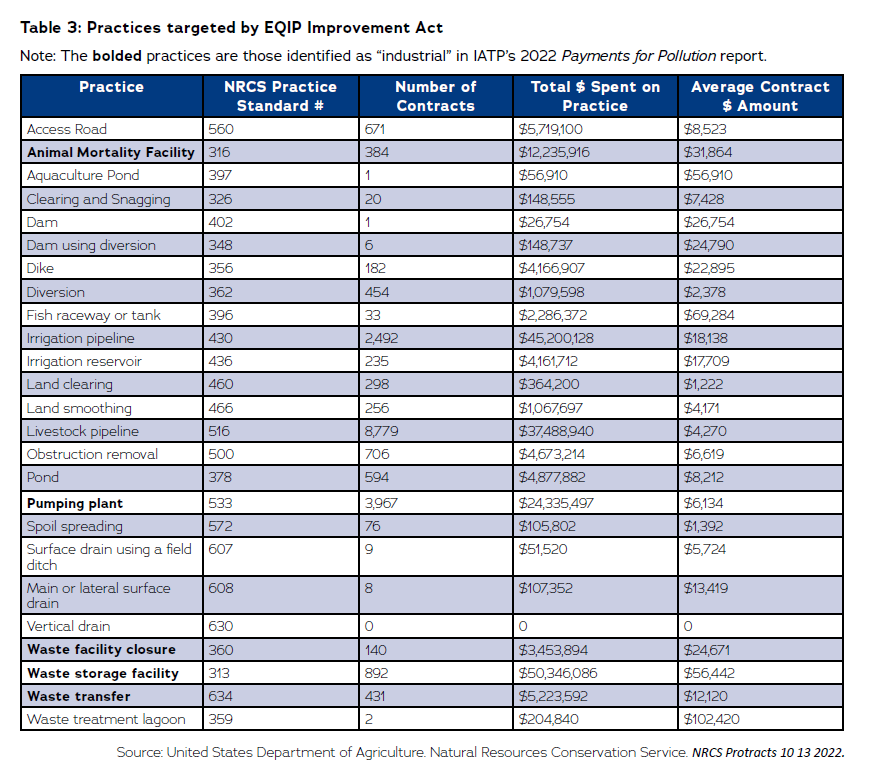
What are some examples of cost-effective, climate-resilient EQIP practices?
The below table highlights a handful of climate-resilient EQIP practices that can serve as cost-effective alternatives to the more expensive structural and industrial practices. Some of these practices help build soil health and soil organic carbon, while others, such as high tunnel systems, windbreaks and multi-story cropping, can help farmers insulate their crops from extreme weather events and improve productivity. Others, such as silvopasture and prescribed grazing, work to better integrate livestock and natural systems. As with any practice, not all of these are useful in all contexts — there are many parts of the country where a riparian forest buffer is not possible, for example. Farmers and researchers are continuing to learn more about ways to conserve soil and water in dry conditions, and whether practices like those in Table 4 can be useful on such farms.
USDA has worked to incorporate local and regional climate realities into its resource conservation priorities, and its existing structures, such as county committees and State Technical Advisory Committees (STACs), can be good tools to ensure conservation programs work for climate resilience regardless of location. More can be done to better incorporate climate resilience into these advisory bodies, as well as the funding that ultimately comes from the USDA.
The list of practices below is not comprehensive but provides a sample of conservation practices that are both cost-effective and can be climate resilient.
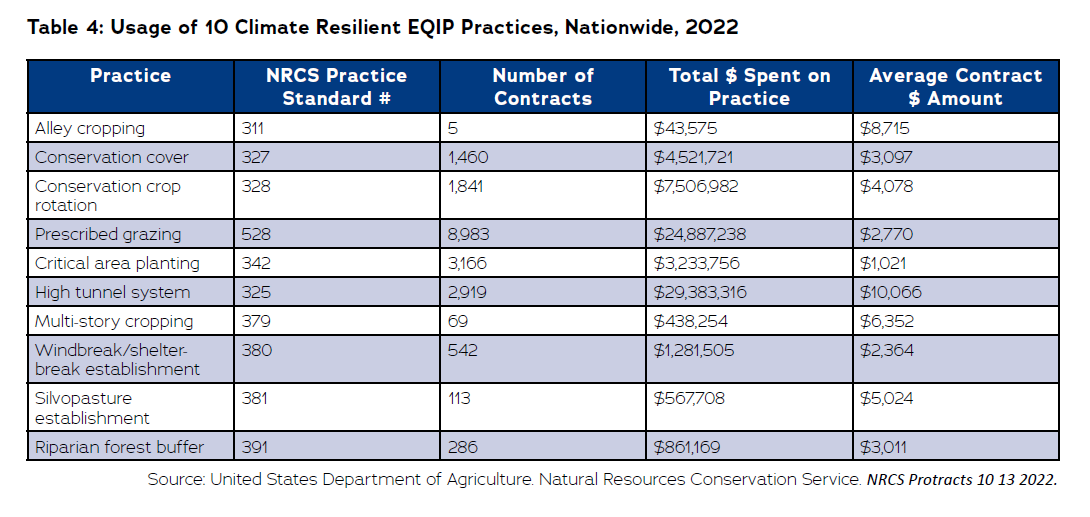
EQIP and Irrigation
Comparing EQIP practices in the Eastern U.S. to the West, one major difference becomes apparent immediately: irrigation. In almost every Western state, irrigation-related practices are present in the top five EQIP practices by total amount of money spent. In the case of California, three of the top five practices by dollars spent are irrigation-related practices.
In an era of erratic rainfall and drying aquifers, the question arises: Should an environmental program such as EQIP be paying for expensive irrigation projects? The answer? It depends.
In California, it is practically impossible to grow food in much of the state without some form of irrigation. According to the State of California, over one-third of the U.S.’ vegetables and three-quarters of its nuts and fruits are grown there.13 For the state’s Central Valley, irrigation water comes from reservoirs of rain and melted snowpack from the Sierra Nevada Mountains and other surrounding mountain ranges. In Southern California, the Colorado River is a major source of irrigation water. In both cases, the overall water supply is variable. So far, in 2023, unusually high amount of rain and snow from “atmospheric rivers” has helped bust a years-long drought and ensure the water supply is largely secure this year. However, as we saw in previous years, droughts can be long-lasting and appear with little warning, exacerbated by the more intense heat that comes with climate change.
The water situation in Kansas is different than California. Instead of being reliant on snowpack, much of western Kansas receives its irrigation water from the Ogallala Aquifer. This ancient water lies under the High Plains and has varying levels of depth. The portion of the aquifer that lies under Southwest Kansas is relatively shallow and has been depleted much quicker than it can be replenished. Many farms are digging deeper wells, changing irrigation systems, or giving up on irrigation altogether. In addition, for decades, Kansas has had a policy of “planned depletion,” which essentially mandates the aquifer be drained for the sake of irrigating crops.14 A December 2022 law in Kansas is attempting to address the Ogallala crisis by allowing restrictions on water use, though results may differ across groundwater administration districts.15
As we highlighted in our 2022 report Payments for Pollution, Kansas spends fewer EQIP funds on industrial practices than other states in the Midwest and Great Plains. Some of Kansas’s top EQIP practices include cover crops and brush management. Despite the widespread use of irrigation in the state, unlike California, very few EQIP dollars go to irrigation in Kansas. While the state is at a crossroads when it comes to water, it will be interesting to see if farmers and conservationists turn to EQIP for solutions.
Many of the irrigation practices EQIP pays for are intended to decrease the amount of water used in irrigated fields, practices that are known as “precision irrigation.” EQIP helps pay for micro irrigators and sprinkler style irrigators, which both use less water than traditional flood and furrow irrigation systems. EQIP also helps pay for irrigation pipelines, the smoothing of land for irrigation and pumping plants for moving water. One side effect of precise applicators is they increase soil salinity, which is detrimental for most crops.16 In order to combat excessive soil salinity, excess water beyond what is needed for the plant may be used, sometimes up to 26% more water.17 Precision irrigation technologies may provide “more crop per drop,” but they do not necessarily lead to an overall reduction in water use.
Better monitoring and regulation of water levels in aquifers and reservoirs is necessary if irrigation agriculture is to continue in much of the U.S. In places where feasible, more support should be provided for growers who wish to adopt dry farming practices.
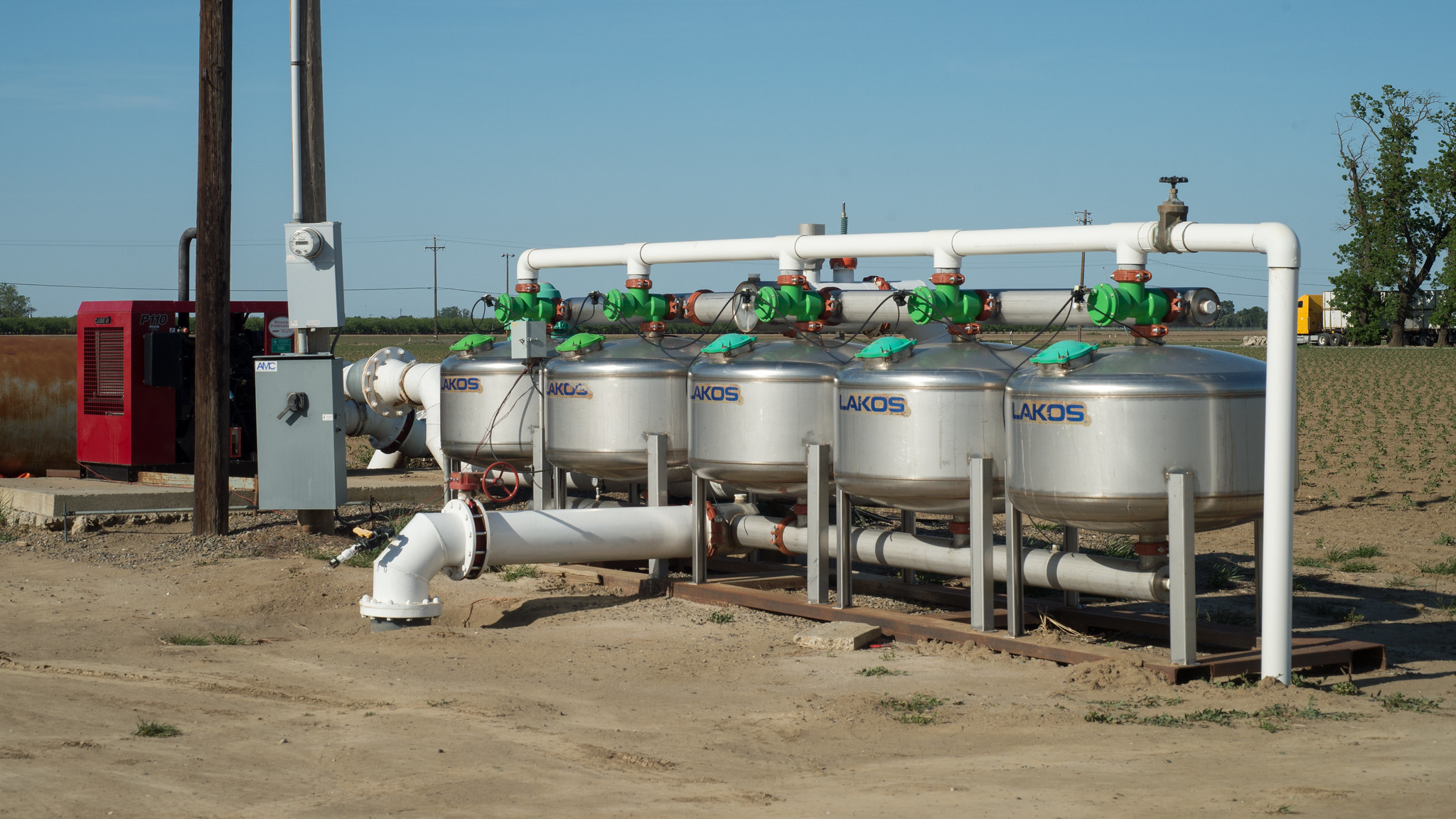
What is Combustion System Improvement?
In California, the top EQIP practice by dollar amount spent is the “Combustion System Improvement” practice. This practice helps farmers replace or retrofit fossil-fuel burning combustion engines and systems with cleaner and/or more renewable options. While also operating outside of California (it is operating with some success in Puerto Rico), in California, the practice works in tandem with the Carl Moyer Memorial Air Quality Standards Attainment Program to reduce particulate matter and nitrous oxide released from engines, heaters, pumps, tractors and other agricultural combustion systems.18 Considering the high levels of air pollution in places like California’s Central Valley, this practice can go a long way in providing healthier air, especially for farmers, farmworkers and others who spend their days outdoors.
Conclusion
This report further underscores the recommendations we made in Closed Out and Payments for Pollution — there is a great need for additional funds to connect farmers with cost-effective, climate-resilient farming practices. In this vein, Congress should seek to protect funding for conservation agriculture outlined in the Inflation Reduction Act while instituting further reforms akin to the EQIP Improvement Act that divert funding away from costly, high emissions industrial-scale practices and toward proven practices that insulate farmers from the shocks of climate change.
The effects of climate change are real, and they are happening now. We must do what we can to mitigate what we can and adapt to the rest. With reforms, EQIP can play a meaningful role in both mitigation and adaption.
Notes & Endnotes
The information provided and the positions expressed in this document are the sole responsibility of IATP, and
not those of the reviewers or other contributors.
Note on Data:
IATP acquired all the NRCS data used for this report via a direct request to NRCS staff. The data reflects
program usage in Fiscal Year 2022. The top five EQIP practices in each state in Fiscal Year 2022 are shown in
the appendix to this report.
Acknowledgments:
• Brian Shobe, California Climate and Agriculture Network
• Nick Levendofsky, Kansas Farmers Union
• Natural Resources Conservation Service Data Staff
All photos included are public domain images used courtesy of the USDA.
Endnotes:
1. Intergovernmental Panel on Climate Change. AR6 Synthesis Report: Climate Change 2023. 2023. Accessed April 13, 2023. https://www.ipcc.ch/report/ar6/syr/.
2. Girija Veni, V., Ch. Srinivasarao, K. Sammi Reddy, K.L. Sharma, and Ashish Rai. “Soil health and climate change,” in Climate Change and Soil Interactions, ed. Majeti Narasimha Vara Prasad and Marcin Pietrzykowski (Cambridge, Massachusetts: Elsevier, 2020), 751.
3. National Association of Local Boards of Health. Understanding Concentrated Animal Feeding Operations and Their Impact on Communities. 2010. Accessed April 13, 2023. https://www.cdc.gov/nceh/ehs/docs/understanding_cafos_nalboh.pdf.
4. American Society for the Prevention of Cruelty to Animals. Revealing the Problem with Factory Farming. https://www.aspca.org/protecting-farm-animals/problem-factory-farming. Accessed April 27, 2023.
5. United States Department of Agriculture. Natural Resources Conservation Service. NRCS Protracts 10 13 2022.
6. Environment America. Agricultural Waste Lagoons: Accidents Waiting to Happen. https://environmentamerica.org/wp-content/uploads/2022/08/AccidentsFactsheet-ManureLagoons-1.pdf. Accessed April 25, 2023.
7. Natural Resources Conservation Service. Conservation Practice Standards. https://www.nrcs.usda.gov/resources/guides-and-instructions/conservation-practice-standards. Accessed May 10, 2023.
8. NRCS Protracts.
9. Murphy, Sophia and Ben Lilliston. True or False? Evaluating solutions for agriculture and climate change. Institute for Agriculture and Trade Policy. https://www.iatp.org/true-or-false-climate-solutions. Accessed May 3, 2023.
10. United States Department of Agriculture Rural Development. Rural Energy for America Program Renewable Energy Systems & Energy Efficiency Improvement Guaranteed Loans & Grants. https://www.rd.usda.gov/programs-services/energy-programs/rural-energy-america-program-renewable-energy-systems-energy-efficiency-improvement-guaranteed-loans. Accessed May 3, 2023.
11. NRCS Protracts.
12. NRCS Protracts.
13. California Department of Food and Agriculture. California Agricultural Statistics Review 2021-2022. https://www.cdfa.ca.gov/Statistics/PDFs/2022_Ag_Stats_Review.pdf. Accessed April 23, 2023.
14. Kansas Geological Survey. Sustainable Development of Water Resources. https://www.kgs.ku.edu/Publications/pic9/pic9_3.html. Accessed May 5, 2023.
15. Condos, David. With the Ogallala Aquifer drying up, Kansas considers limits to crop irrigation. Kansas News Service. April 9, 2023. Accessed April 24, 2023. https://www.kansas.com/news/state/article274099780.html.
16. Nickel, Raylene. New life for saline soil. Here’s how some perennial grasses can lower soil salinity. Successful Farming. 2017. https://www.agriculture.com/crops/cover-crops/new-life-for-saline-soil. Accessed April 25, 2023.
17. Hanson, Blaine R. and Warren E. Bendixen. University of California, Agriculture and Natural Resources. Drip irrigation controls soil salinity under row crops. California Agriculture 49(4): 19-23. https://doi.org/10.3733/ca.v049n04p19. Accessed April 18, 2023.
18. California Air Resources Board. Carl Moyer Memorial Air Quality Standards Attainment Program. https://ww2.arb.ca.gov/our-work/programs/carl-moyer-memorial-air-quality-standards-attainment-program. Accessed May 10, 2023.
19. NRCS Protracts.
Downloads:
Download a PDF of the Appendix.
Download a PDF of the report.